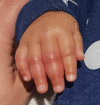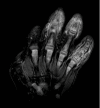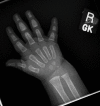Microgeodic disease in an infant
- PMID: 36038154
- PMCID: PMC9438064
- DOI: 10.1136/bcr-2021-245179
Microgeodic disease in an infant
Abstract
We describe an infant presenting with intermittent discolouration and swelling of her fingers and toes occurring with changes in ambient temperature. Extensive investigations revealed raised inflammatory markers as well as sclerotic lesions within the phalanges and diffuse marrow oedema. Infectious and inflammatory causes were considered and excluded based on the clinical presentation and investigation findings. The persistence of symptoms prompted further investigation with MRI. Correlation of the MRI findings with previous case reports resulted in a diagnosis of microgeodic disease-an uncommon, self-limiting condition thought to be due to cold-induced vasospasm leading to avascular necrosis of the bone.
Keywords: Dermatology; Paediatrics; Primary Care; Rheumatology.
© BMJ Publishing Group Limited 2022. No commercial re-use. See rights and permissions. Published by BMJ.
Conflict of interest statement
Competing interests: None declared.
Figures







References
-
- Davis A. Microgeodic disease. Christchurch: DermNet NZ; 2013. https://dermnetnz.org/topics/microgeodic-disease/
-
- Maroteaux P. [5 cases of microgeodic disease of phalanges of unknown etiology in infants]. Ann Radiol 1970;13:229–36. - PubMed
Publication types
MeSH terms
LinkOut - more resources
Full Text Sources
